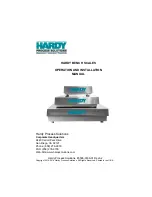
USER MANUAL
11
__________________________________________________________________________________________________________________
9. General operation principles
1.
In order to confirm correctness of the scale during its operation, before
starting and after finishing every valid measurement series it is recommended
to check weighing accuracy putting calibration weight or other object of
exactly known mass on the scale. In the case when allowable measurement
error of the scale is exceeded, it is recommended to perform calibration with
external weight or contact authorised service centre.
2.
Weighed mass should be placed in the middle of the pan.
3.
The scale allows taring in the whole measuring range. To tare the scale press
→
T
←
key. Taring does not extend measuring range, but only subtracts tare
value from mass value of a sample placed on the pan. To make the control of a
load on the pan easier and to avoid exceeding measurement range, the scales
have load indicator calibrated 0÷100%.
4.
Weighing result should be read when the indicator
lights, which signalises
result stabilisation.
5.
When the scale is not used but it is necessary for it to be ready to work, it can
be switched off by pressing I/ key. The scale reading system is then switched
off and scale goes to standby mode signalled with
OFF
indicator. Switching
the scale on is preformed by pressing I/ key.
6.
In sales having
→
0
←
key (zeroing) active it should be checked if zero
indicator
→
0
←
is displayed before sample is placed on the pan. If not, press
→
0
←
key and wait until the scale is zeroed and zero indicator appears. After
that load can be placed on scale pan.
7.
Scale mechanism is a precise device sensitive to overweight, mechanical
shocks and strokes.
Do not overload the scale more than 20% of maximum capacity.
Do not press the pan with a hand.
For transportation pan, pan support and pan ring should be packed
separately.












































